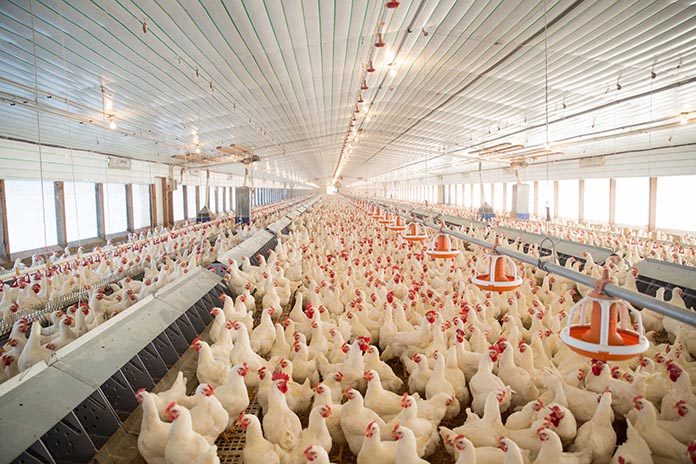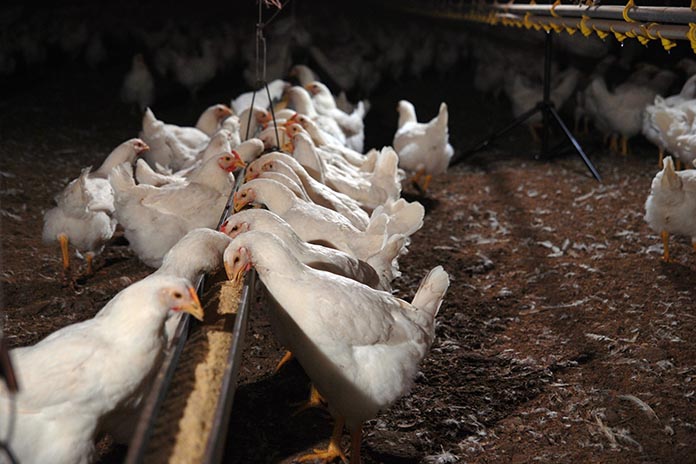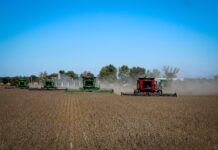
Broiler breeders are expected to produce about 150 chicks in 40 weeks of production and even though it is commonly believed that selection for more meat in the broiler leads to fewer chicks from the parent stock, breeding companies have actually increased the number of chicks per year while improving broiler traits like feed conversion and breast meat yield.

Broiler breeder nutrition is a challenge. We feed our hens to express their genetic potential to produce eggs, but must also ensure the eggs they produce are safe, free of contaminants and contain all the nutrients needed for hatching healthy broiler chicks.
Breeder nutrition is about consistency of feed while broiler nutrition is about economics. Experienced people regard breeder nutrition as both a science and an art, with much depending on the way we feed birds and when and how much we do this.
Broiler nutrition, on the other hand, has to provide for rapid growth. Broilers have plenty of feed all the time, and we have less time to make up for early mistakes. As nutritionists we must support the breeder production team to achieve their goals by providing innovative and consistent feeds. There are some areas of nutrition we need to re-evaluate.
Energy, protein and amino acids
Broiler breeder nutrition depends on managing the allowance of feed. Nutrient intake is really what counts to achieve production goals. Lower density feeds with low nutrient formulation provide a higher volume to distribute, and this is when nutritionists need to ensure availability and consistency of the ingredients.
During the rearing phase, there are three key periods where the pullet needs a different nutrition:
- From 1-4 weeks, the pullet needs to build a good frame, so this feed usually provides 2868 kcal/kg and 18.5—19.5% protein. The modern pullet achieves the four-week standard weight more easily nowadays and so some restriction of feed is usually necessary after 14 days.
- The second period is between 5-16 weeks – a maintenance period where we need to avoid overweight pullets. The energy usually drops to between 2530 and 2750 kcal/kg depending on ingredient availability with 14 – 15% protein, 0.58 – 0.63% DLys. Depending on the country and ingredients available, nutritionists can use wheat by-products such as wheat middling’s and shorts, rice hulls, soy hulls, DDGS, oat hulls, and other ingredients to achieve this low energy/low protein and to keep the bodyweight and uniformity of the pullets on target. Pullets have become more efficient so they need less nutrients to achieve their standard weights. Nutritionists can formulate lower density and consistent feeds to maintain feed volume and help achieve a uniform flock.
- The third phase is usually from 17 – 24 weeks – a preparation period for laying when the hens need to have an incremental weight gain of 30 – 40% from 16 to 20 weeks. Again, this can be achieved by increasing the energy and protein or increasing the allowance with the grower feed.
A transitional feed between grower and breeder feed is called pre-breeder (typically 19 to 23 weeks). There are different approaches to a pre-breeder (developer) feed, but most important is that it needs to support the management on the farm. In the past, a pre-breeder was sometimes nothing more than a grower with more calcium, but there is limited research to support the need for increased calcium levels when the hens are not laying. Moreover, supplying the pre-breeder now at 16 weeks is 3-4 weeks earlier compared to a few years back. Normally a pre-breeder feed is formulated to support the physiological changes in the hen preparing her for production.
Light stimulation and transfer of the pullet to the hen house usually occurs at 20 to 22 weeks. After the pre- breeder feed is changed to the production phase feed at first egg or 1% production, the hen is going through many physiological changes. We need to help during this transition by adjusting the nutrients levels. Energy and protein/amino acids increase, but the nutrient that increases more drastically is calcium more than 3 times that of the previous phase due to eggshell formation.

Vitamins and minerals
There are about 40 essential nutrients for poultry and vitamins + minerals make up more than 70% of them, however there is limited research on these requirements. Common sense leads us to increase the vitamin premix by 10 to 20% of recommended levels, due to lower feed intakes, to achieve the standard bodyweight and improve egg production. Minerals are diverse and some of them, such as Zn and Se, are usually regulated by the government in some countries due to environment pollution and toxicity respectively. Excess minerals are excreted, increasing the contamination to the environment, so nutritionists are using more available sources of trace minerals such as organic minerals, in combination with better inorganic sources and exogenous enzymes.
Exogenous enzymes
Phytase is the most common exogenous enzyme used in poultry feeds. Since broiler breeders require high calcium levels, the use of phytase has been slowly increased based on information from table egg laying hens. Phytase activity has been shown to decrease with high calcium levels in broiler trials; however, the calcium used in broiler feeds has higher solubility and low particle size (around 600 um) than the coarse limestone used in breeders (>1500 um). This may have changed phytase activity in breeder feeds, allowing its use, but more research is still needed. Not only is phytase used in breeder feeds, but carbohydrases are used as well, depending on the need to target specific substrates in different countries. Exogenous enzymes unlock the nutrients trapped in feed ingredients, and decrease anti nutritional factors, so constant evaluation is required to lower the feed cost and improve performance.
Additives
Feed additives are mostly used to improve the shelf life of feeds, or provide a better intestinal microflora. This is probably the largest group of ingredients in the market, and our job as nutritionists is to find the best way to evaluate and use them. With more companies switching to ABF (antibiotic free) production, more products are being tested.
The forgotten male feed
During the rearing period, males are fed with the same feed as the females. Since the normal ratio of males to females is between 8 & 10 per 100, it is more practical to feed males with the same feed as the hens; however, the male has different nutrient requirements. The modern male is becoming more feed efficient every year, so they need less feed to achieve the standard weights and keep in shape for successful mating activity. In addition, we need to maintain feed volume to allow better feed distribution and proper uniformity. In companies which use a female feed for the males, this becomes more difficult.
When males are fed hen feed, they get an unbalanced energy/protein and amino acids ratio, and high calcium is not needed. There are some disadvantages to separate male feeding, with small volumes for the mills increasing feed inventory and the need for more bins, longer time at the farms, and the risk of allocating male feed in the hen bins. However, with proper management, separate male feeding can become a reality and beneficial in improving fertility by +1.5 to 2%. Some countries use it very successfully, but others are still working on it.
Conclusion
Broiler breeder nutrition is about feed consistency, avoiding too many variable ingredients. ABF (antibiotic free) production and animal welfare concerns are changing the way we will feed broilers and broiler breeders. At Cobb-Vantress, Inc. we keep evaluating ingredients, nutrient requirements, and feed strategies to enable innovative and affordable feeds to help achieve the genetic potential of our broiler breeders.
















